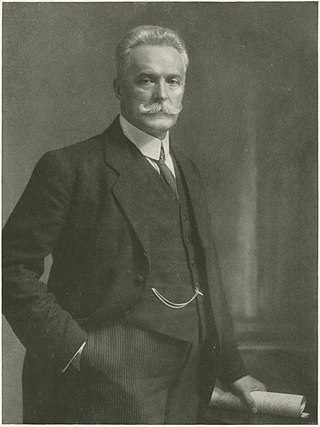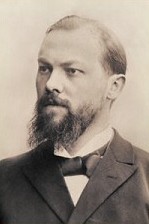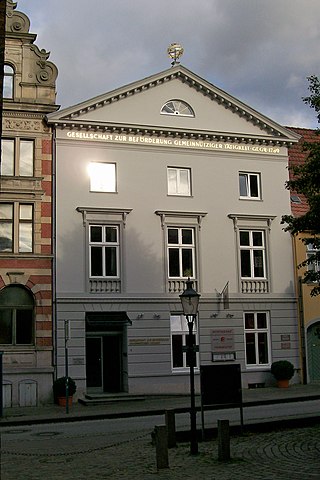Related Research Articles

Gustav Landauer was one of the leading theorists on anarchism in Germany at the end of the 19th and the beginning of the 20th century. He was an advocate of social anarchism. As an avowed pacifist, Landauer advocated the principle of "non-violent non-cooperation" in the tradition of Étienne de La Boétie and Leo Tolstoy.
Der Tunnel über der Spree was a German literary society based in Berlin, founded on 3 December 1827 by Moritz Gottlieb Saphir. Most active between 1840 and 1860, it acquired 214 members and influenced literary life in Berlin for more than seventy years.

Heinrich Herkner was a German economist as well as a social reformer.

Wilhelm Bölsche was a German author, editor and publicist. He was among the early promoters of nature conservation and committed to popularizing science.

Wolfgang Kraushaar is a political scientist and historian. After a residency at the Hamburger Institut für Sozialforschung from the 1980s until 2015. In 2015 he continued his research at the Hamburg Foundation for the Promotion of Science and Culture also in Hamburg, Germany.

Gustav Adolf Deissmann was a German Protestant theologian, best known for his leading work on the Greek language used in the New Testament, which he showed was the koine, or commonly used tongue of the Hellenistic world of that time.

The Gesellschaft zur Beförderung gemeinnütziger Tätigkeit is Lübeck's oldest charitable organization.
Neue Marx-Lektüre or NML is a revival and interpretation of Karl Marx's critique of political economy, which originated during the mid-1960s in both Western and Eastern Europe and opposed both Marxist–Leninist and social democratic interpretations of Marx. Neue Marx-Lektüre covers a loose group of authors primarily from German-speaking countries who reject certain historicizing and empiricist interpretations of Marx's analysis of economic forms, many of which are argued to spring from Friedrich Engels role in the early Marxist workers' movement.

The Studentendorf Schlachtensee is a heritage listed building complex of residential and community buildings in Berlin. It was built in the 1950s and was planned as a residence for students of the Free University of Berlin. Based on the model of the Studentendorf Schlachtensee, the Studentendorf Adlershof opened in October 2014 on the campus of Humboldt University in Berlin's Adlershof district.

Die Krokodile was a small poets' society in Munich which existed from 1856 to the 1870s.

Erich Mühsam was a German antimilitarist anarchist essayist, poet and playwright. He emerged at the end of World War I as one of the leading agitators for a federated Bavarian Soviet Republic, for which he served five years in prison.
German individualist philosopher Max Stirner became an important early influence in anarchism. Afterwards Johann Most became an important anarchist propagandist in both Germany and in the United States. In the late 19th century and early 20th century there appeared individualist anarchists influenced by Stirner such as John Henry Mackay, Adolf Brand and Anselm Ruest and Mynona.

Gustav Adolf Warneck (1834–1910) was a German missiologist. In 1874, he established the first German missiological journal, Allgemeine Missionszeitschift. He was also involved in the founding of the German Protestant Missions Committee in 1885, serving as secretary until 1901. He held the first university chair in missiology at Halle University from 1896 to 1908. He is considered to be one of the first missiologists. David Bosch describes him as "the father of missiology as a theological discipline."

Felix Hollaender was a German writer, critic, dramaturge and theatre director. At one point he worked as a stage producer with his friend Max Reinhardt.
The Ludlamshöhle was a literary society founded by the Austrian playwright Ignaz Franz Castelli together with August von Gymnich in Vienna, Austria, in 1819, which existed until 18 April 1826.
Volkmar Leimert is a German composer and dramaturg.
Friedrich Gustav Schilling was a German musicologist, editor and lexicographer.
Peter Sühring is a German musicologist, publicist and music critic.
The Gemeinschaft der Eigenen was a German homosexual advocacy group led by anarchist Adolf Brand. The group opposed the country's preeminent advocacy group, Magnus Hirschfeld's Scientific-Humanitarian Committee.
Heinrich Christoph Koch was a German music theorist, musical lexicographer and composer. In his lifetime, his music dictionary was widely distributed in Germany and Denmark; today his theory of form and syntax is used to analyse music of the 18th and 19th centuries.
References
- 1 2 Engel, Amir (November 2022). "From the Neue Gemeinschaft to Bar Kochba: The Jewish Communitas or the Idea of Jewish Politics as Mysticism". Religions. 13 (12): 1143. doi: 10.3390/rel13121143 . ISSN 2077-1444.
- ↑ Burkhardt, Albert. "Der Friedrichshagener Dichterkreis. Ein Rundgang auf den Spuren der Dichter". Friedrichshagener Hefte (14).